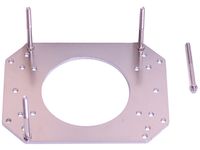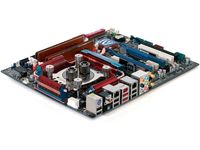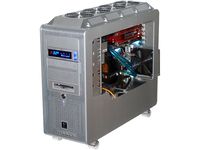Three High-End Liquid-Cooling Cases Compared
PC5-1326SL Installation and Operation
CPU-340 attachment hardware includes a base plate with mounting holes for several different socket types and four threaded pins. Unfortunately, we found out upon bumping one of the pins that the threads in our sample didn’t provide much support. A mere three threads are intended to hold the pieces together, and the fit simply wasn’t tight enough. Koolance promptly sent replacement parts with the tight thread fit needed to make its design work.
Not content to wait for shipping, we decided that it would be better to simply thread some long screws all the way through the plate from the back side. Screw heads provided two advantages over threaded pins in that they positively eliminate pull-through, and that they tighten into the plate, rather than working their way out of the plate, when spring-nuts are removed.
While the replacement parts were still in transit, the water block was installed using #6-32 UNC screws of 1.75” length rather than the stock threaded pins. A later test fit of the replacement parts proved that the threaded pins functioned identically, though we still have a little more faith in the added support that ordinary screws offer.
With the cooling block attached, we installed the motherboard into the case, followed by hard drives, a power supply, and graphics cards. The only added effort was to cut the coolant lines to length and “burp” the system.
“Burping,” or removing air from the system, was as easy as filling the RP-1000SL reservoir and powering the system on. But we didn’t want any power going to the motherboard before coolant reached the CPU. Koolance includes a jumper wire and instructions for turning on an ATX power supply without having it attached to the motherboard. The pump is capable of pushing air out of the radiator, even though the radiator sits above it, but getting the coolant moving at first required us to set the pump to its highest speed.
The RP-1000SL includes separate 10-step controls for pump and fan speeds, and both controls can also be set to automatically increase cooling power as temperatures increase.
At the lowest settings, the pump is nearly silent while the fans make a low-pitched whir at a noise level typical of pre-built systems. Setting the pump to its highest-speed setting results in a high-pitched whine, which is somewhat muffled by nearby components. Fans roar quite loudly at full speed, with an estimated maximum noise output of around 47 db based on the number and type of fans included in our kit.
Get Tom's Hardware's best news and in-depth reviews, straight to your inbox.
While the fans are somewhat noisy, the case does a surprisingly adequate job of containing internal noises such as graphics card fans, in spite of its ventilated face and back panels. The noise reduction is likely due to the non-ventilated side panels, but Koolance prefers its buyers to select from the wide range of graphics and chipset coolers the company offers.
Current page: PC5-1326SL Installation and Operation
Prev Page Koolance PC5-1326SL Design and Features Next Page Zalman Z-Machine LQ1000 Design and Features-
or buy a cheap case... mod it with a 50 $ dremel... and then add your own watercooling setup and get much better cooling performance...Reply
thats what i'm going to do... not buy some case w/ water cooling.... unless its like a modded lian-li case... but those are like 800 bucks... so no thanks -
nerrawg Whoa the 4870 is still a pretty hot one even with that massive Koolance radiator. I wonder if that can be improved using a custom build with 2 separate loops and radiators - would be a bit more hassle though. Also be interesting to see how it compares to a 4870 X2 - my first assumption would be the X2 is hotter but that might not be the case as there could be a larger flow and surface area to allow for more heat dissipation. If your talking W/C for silent running, then custom built systems with big passive radiators (Toyota anyone?) and a good pump or 2 has to be the only true solution. Otherwise you're just running fans like an air cooling rig and the name of the game is still who has the quietest one..Reply -
yadge nerrawgWhoa the 4870 is still a pretty hot one even with that massive Koolance radiator. I wonder if that can be improved using a custom build with 2 separate loops and radiators - would be a bit more hassle though. Also be interesting to see how it compares to a 4870 X2 - my first assumption would be the X2 is hotter but that might not be the case as there could be a larger flow and surface area to allow for more heat dissipation. If your talking W/C for silent running, then custom built systems with big passive radiators (Toyota anyone?) and a good pump or 2 has to be the only true solution. Otherwise you're just running fans like an air cooling rig and the name of the game is still who has the quietest one..Reply
I'm pretty sure the videocards weren't water cooled. -
nerrawg Hehe whoops you're right - I guess I should have looked at the pics - no wonder it was so hot. Don't understand why they didn't use some splitters and cool 4870beast #1. Can't see how you can complain about noise and temp when you're not even using your full 750-1000W water cooling capasity. Also good eye editor on changing frames per sec to temperature celsius on graph X axis.Reply -
gaiden nice info, though i'm not sure, as hardware gets smaller - lesser heat, would i need a water-cooled setup. personally i think fan setup with a top of the line HS would do plenty. the TJ-09 and Lian Li's are very well built - i have a 7 fan setup + IFX-14 in a lian li 2100 plus II cant hear anything at all. (though it really helps to get good fans :) for GPU's there are several 'spot-cooler' options. overall 7-8 'good' fans + 1 'awesome' cooler would cost only less than 1/2 of the $500 TH spent on water-cooled solution, and the air-cooled should improve air movement inside the case as well.Reply -
stoner133 I find it strange that the video card temps are so high, I run a Koolance system and using their waterblocks on both of my 4870's in crossfire my temps never get above 42c after hours of playing Crysis and my coolent reaches the GPU's after it goes thru the CPU waterblock. The two degree temp difference does happen, AOD does show the first card at 40c while the second is 42c.Reply -
stoner133 thogromor buy a cheap case... mod it with a 50 $ dremelhttp://en.wikipedia.org/wiki/Dremel ... and then add your own watercooling setup and get much better cooling performance... thats what i'm going to do... not buy some case w/ water cooling.... unless its like a modded lian-lihttp://en.wikipedia.org/wiki/Lian_Li case... but those are like 800 bucks... so no thanksThe Koolance cases are modded Lian Li cases and there no where near $800, they start at just under $400 and go to just over $600Reply -
Shadow703793 They could have silver plated the Koolance CPU-340 block instead of gold plating it (silver > than gold in heat transfer).Reply
These kits are worth an entire PC so imo, I would mod it my self. It's not that hard to do, providing you have the time to do it. -
Crashman Reply9463632 said:The Koolance cases are modded Lian Li cases and there no where near $800, they start at just under $400 and go to just over $600
The case with no pump, water block, or reservoir is $400, but what do you do without the parts? A basic liquid cooling kit from Koolance, complete with only the needed parts, starts at around $600.
Also notice:
Test Configuration
Liquid cooling often offers excellent cooling capacity, but that wouldn’t matter much if hot case air destabilized another part of the system. In order to test both, we used an overclockedhttp://en.wikipedia.org/wiki/Overclocking Intel Core 2 Quad processor to heat the liquid and a pair of HD 4870http://en.wikipedia.org/wiki/Radeon_R700 X2 graphics cards to heat the air.
Graphics was left air-cooled to help determine effectiveness of case airflow. It would have been even better to use two 4850's for that, since they don't vent outside the case.



